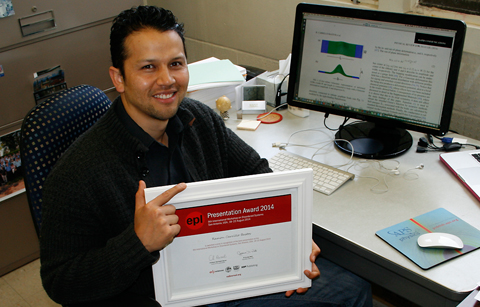By Jean Andrews
Physics & Astronomy
“Attending a conference like this was exciting because I was among specialists who understood my results. That led to thought-provoking conversation for the duration of the event.”
Dr. Ramon Carrillo Bastos, a postdoctoral researcher in the Department of Physics and Astronomy recently attended the 9th International Workshop on Disordered Systems in San Antonio, Texas, where he received an award and cash prize from the European Physical Society Journal (EPS) for the best poster presentation. The EPS is a not for profit association whose members include 42 European national physical societies and research institutions.
His poster on “Electronic transport in graphene nanoribbons with a Gaussian deformation” was based on his paper, “Gaussian deformations in graphene ribbons: Flowers and confinement” which describes research related to the magnetic field of graphene, a one-atom thick sheet of pure carbon. Graphene conducts heat and electricity with great efficiency.
Carrillo Bastos collaborated with co-authors Dr. Nancy Sandler, an associate professor in the department, and three condensed matter researchers located at research centers in Mexico and Brazil.
Carrillo Bastos’s Abstract: The coupling of geometrical and electronic properties is a promising venue to engineer conduction properties in graphene. Confinement added to strain allows for interplay of different transport mechanisms with potential device applications. Narrow strips of the material have been produced by methods such as lithography, unzipping of carbon nanotubes, and chemical techniques. In particular, deposition on patterned SiC substrates produces ribbons with unusual large conductivities, suggesting a strong connection between strain and conductance. Furthermore, effects of strain on electronic properties have also been reported in graphene nanobubbles, drumheads and oscillating membranes among others.
To investigate strain signatures on transport in confined geometries, we focus on graphene nanoribbons (GNR) with circularly symmetric deformations. In particular, we study GNR with an inhomogeneous, out of plane Gaussian deformation, connected to reservoirs. A tight-binding model is solved with the recursive Green’s function method, to obtain conductance, density of states and local density of states. Results are compared with a Dirac model solved by iterative scattering matrix methods.
We observe an enhancement of the density of states in the deformed region, accompanied with a decrease in the conductance, signaling the presence of confined states. The local density of states exhibits a six-fold symmetric structure with oscillating sub-lattice occupation asymmetry that persists for a wide range of energy and model parameters. The microscopic model reveals sublattice symmetry breaking within each fold, consistent with experimental observations. An external magnetic field magnifies the confinement, but does not restore the sublattice symmetry breaking.
















Comments